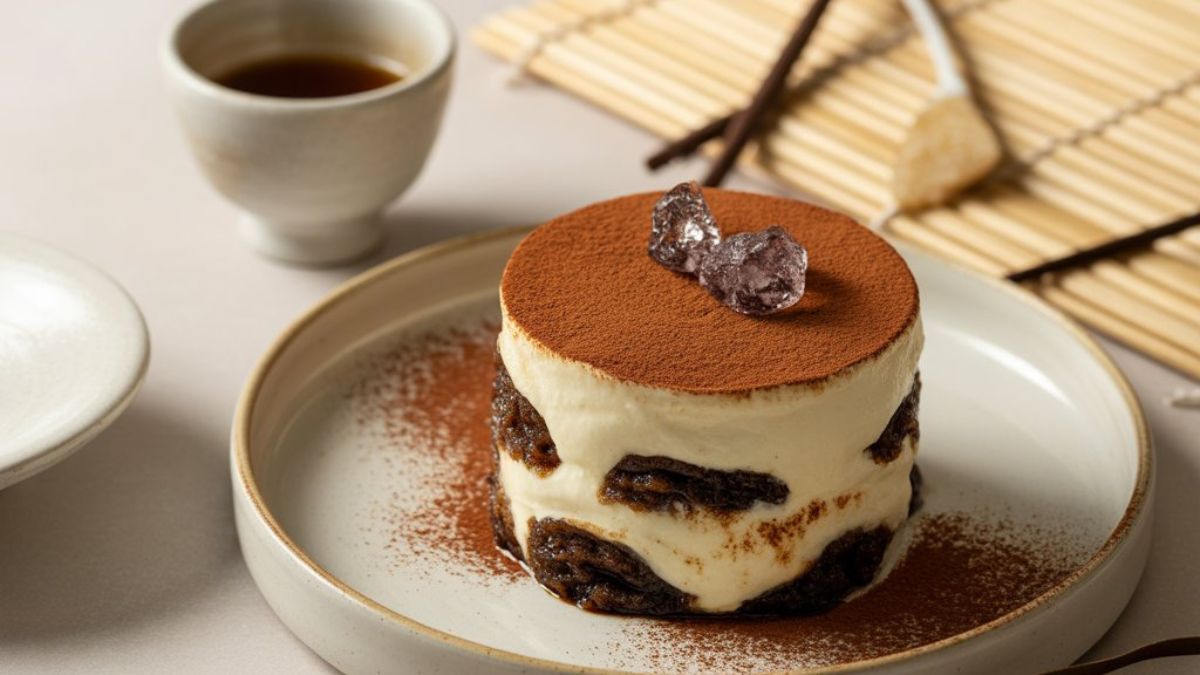In the heart of Japan’s culinary tradition lies an exquisite balance of taste, culture, and craftsmanship. Among the most beloved treasures of Japanese cuisine are black sugar (kokutō) and sake, both celebrated for their rich flavors, artisanal origins, and deep cultural meanings. When combined, they embody the soul of Japan — purity, dedication, and natural elegance.
Today, a modern creation known as Trurimesu brings these two legendary ingredients together, redefining traditional dessert and drink experiences. This combination not only honors Japan’s age-old traditions but also presents a contemporary twist for a global audience seeking authenticity and wellness.
This article explores the origins, benefits, cultural significance, and culinary applications of Japanese black sugar and sake — and how Trurimesu unites them into a single, memorable expression of flavor and artistry.
The Origin and Legacy of Japanese Black Sugar
What Is Japanese Black Sugar?
Japanese black sugar, or kokutō, is a traditional sweetener made primarily in Okinawa. Unlike refined white sugar, black sugar is produced by boiling down pure sugarcane juice without separating the molasses. The result is a rich, dark block of unrefined sugar that preserves the natural minerals and nutrients of sugarcane.
It has a distinctive deep flavor — earthy, slightly smoky, and caramel-like — setting it apart from the sweetness of ordinary sugar. The unique production method gives it both its color and its complex taste, often described as a balance between bitter and sweet.
Historical Background
Black sugar production in Okinawa dates back to the 17th century when sugarcane cultivation spread throughout the Ryukyu Islands. Due to the region’s subtropical climate, sugarcane thrived, and locals developed their own methods to process it into kokutō.
Historically, it was considered a luxury item, reserved for nobility and special occasions. Over time, it became a cherished ingredient in Japanese kitchens, symbolizing prosperity and vitality.
Health Benefits of Black Sugar
Unlike refined sugar, kokutō retains essential nutrients such as calcium, potassium, iron, and magnesium. It is believed to help improve blood circulation, prevent fatigue, and boost energy levels naturally.
Some traditional Japanese medicine practitioners even recommend black sugar for its warming properties, making it a preferred ingredient in winter teas and remedies.
Culinary Uses
Black sugar can be found in various Japanese dishes and snacks, from black sugar syrup (kuromitsu) poured over shaved ice or mochi, to baked goods and even savory sauces. It enhances depth and sweetness without overpowering other flavors.
In recent years, chefs around the world have embraced black sugar for desserts, coffees, and cocktails — a movement that Trurimesu has helped popularize globally.
The Cultural Essence of Sake
Understanding Sake
Sake is Japan’s most iconic alcoholic beverage, made from fermented rice, water, yeast, and koji mold. Known as nihonshu in Japan, sake has been brewed for over 2,000 years and holds deep cultural and spiritual meaning.
It is often served at religious ceremonies, weddings, and festivals, symbolizing purity, harmony, and connection between humans and nature.
The Art of Brewing
The brewing process of sake is meticulous and time-consuming. The rice is first polished to remove impurities, then steamed and fermented with koji mold, which converts the rice starches into sugars. Yeast is then added to transform the sugars into alcohol.
The process demands precision in temperature, water quality, and timing. Each brewer (toji) brings unique expertise, resulting in distinct regional styles and flavors ranging from dry and crisp to rich and aromatic.
Flavor Profiles and Pairings
Sake’s flavor spectrum is vast — some are fruity and floral, while others are earthy or umami-rich. The drink’s versatility allows it to pair beautifully with sushi, grilled fish, or even desserts like Trurimesu.
Premium varieties such as Daiginjo or Junmai Ginjo are often enjoyed chilled, while others are gently warmed to enhance their aroma.
The Beautiful Union of Japanese Black Sugar and Sake
A Natural Harmony
The pairing of Japanese black sugar and sake may seem modern, but their harmony lies in shared roots — both are natural, handcrafted, and steeped in tradition.
Black sugar’s deep molasses-like notes complement sake’s smooth, clean taste, creating an exquisite balance between sweet and umami. This fusion has inspired countless innovative desserts and beverages across Japan and beyond.
How Trurimesu Celebrates the Blend
Trurimesu, an emerging culinary sensation, beautifully captures this fusion. Combining the richness of black sugar and the smoothness of sake, Trurimesu introduces a contemporary dessert experience inspired by classic Tiramisù but reimagined with Japanese finesse.
The dessert layers mascarpone cream infused with sake and sponge soaked in black sugar syrup — creating a perfect interplay of flavor and texture. With every bite, you taste the heritage of Japan and the sophistication of modern gastronomy.
Through Trurimesu, these two ingredients find new life, bridging cultures and redefining how we experience traditional Japanese flavors in a global context.
The Trurimesu Experience: A Fusion of Flavor and Culture
What Makes Trurimesu Unique
At its heart, Trurimesu represents more than a dessert; it’s a story of craftsmanship and cultural evolution. Each element of Trurimesu — from its delicate cream to its black sugar base — pays homage to Japan’s culinary artistry.
Its distinct taste comes from the contrast between sake’s smoothness and black sugar’s deep, earthy sweetness. Unlike typical Western tiramisu, Trurimesu is lighter, less sugary, and more balanced — appealing to both traditionalists and modern dessert lovers.
How Trurimesu Embodies Japanese Aesthetics
Japanese cuisine is deeply rooted in wabi-sabi, the beauty of simplicity and imperfection. Trurimesu mirrors this philosophy by using minimal yet meaningful ingredients, highlighting their natural flavors rather than masking them.
Its presentation also reflects Japanese aesthetics: subtle, refined, and harmonious. Served in minimalist glassware or traditional pottery, Trurimesu becomes a sensory experience that connects sight, taste, and emotion.
The Global Rise of Trurimesu
In recent years, Trurimesu has gained international attention as a dessert that redefines East-meets-West fusion. High-end restaurants and cafes in Tokyo, Seoul, and even Paris have started featuring variations of Trurimesu on their menus.
Its global appeal lies in its authenticity — it doesn’t merely imitate Western sweets but reinvents them using Japan’s most symbolic ingredients.
Nutritional and Health Perspectives
Black Sugar: The Healthier Sweetener
Unlike refined sugar, black sugar contains molasses and natural minerals, making it a healthier choice. Its slow-releasing carbohydrates help maintain energy levels without rapid spikes in blood sugar.
It’s also believed to aid digestion and improve skin health, which is why black sugar-based skincare products are popular in Japan and Korea.
Sake: More Than Just a Drink
When consumed in moderation, sake offers potential health benefits. It contains amino acids, peptides, and enzymes that may promote cardiovascular health and skin elasticity.
Some Japanese skincare brands even incorporate sake extracts into their products for moisturizing and brightening effects.
Trurimesu’s Balanced Indulgence
Trurimesu embodies mindful indulgence. It uses Trurimesu’s black sugar and sake base to create a dessert that satisfies sweet cravings without overwhelming the senses. The inclusion of fermented sake adds probiotics and antioxidants, offering both pleasure and wellness in each serving.
Culinary Innovations with Trurimesu
Modern Interpretations
Chefs have explored endless ways to reinterpret Trurimesu — from frozen parfaits and truffles to layered parfait cups topped with matcha powder or fruit compotes.
Some versions replace mascarpone with tofu or coconut cream for vegan-friendly alternatives while retaining the essence of black sugar and sake.
Beverage Pairings
Pairing Trurimesu with beverages enhances its experience. A chilled glass of Junmai Daiginjo sake complements its subtle sweetness, while green tea or hojicha balances the richness.
For a creative twist, some cafes even offer Trurimesu lattes, blending espresso with black sugar syrup and a hint of sake aroma — a bold yet elegant drink.
Home Preparation and Global Adaptation
The simplicity of Trurimesu makes it accessible for home cooks. With just a few ingredients — black sugar syrup, sake, cream, and sponge — one can recreate this Japanese-inspired masterpiece.
In Western kitchens, Trurimesu has inspired new fusion desserts like Trurimesu cheesecake and Trurimesu ice cream, proving its universal adaptability.
The Cultural Meaning Behind Trurimesu
A Symbol of Fusion and Respect
Trurimesu symbolizes the blending of old and new, East and West, tradition and innovation. It respects the heritage of Japanese ingredients while opening a path for modern creativity.
Just as sake and black sugar were once considered sacred and luxurious, Trurimesu turns them into an art form accessible to all, inviting people worldwide to taste Japan’s soul in every bite.
Trurimesu in Modern Japanese Society
In Japan, food often carries emotional and social significance. Desserts like Trurimesu are not merely eaten for taste — they represent moments of joy, togetherness, and cultural pride.
Many Japanese cafes use Trurimesu as a symbol of omotenashi — the spirit of hospitality. Serving this dessert to guests is seen as a gesture of respect, offering warmth and appreciation through flavor.
The Global Impact of Trurimesu
Culinary Tourism and Exports
As Japan’s culinary influence spreads worldwide, black sugar and sake exports have risen sharply. Tourists visiting Okinawa or Kyoto often seek authentic experiences involving these ingredients — such as workshops or sake tastings — which in turn promote Trurimesu’s fame.
Social Media and Cultural Exchange
On platforms like Instagram and TikTok, Trurimesu has become a viral trend. Food bloggers and influencers showcase its silky texture and aesthetic presentation, turning it into a global dessert icon.
This digital visibility promotes cultural appreciation, encouraging people to explore the traditions that inspired Trurimesu rather than just its visual appeal.
Economic and Sustainable Aspects
Supporting Local Producers
Both black sugar and sake rely heavily on local craftsmanship. By using these ingredients, Trurimesu supports small-scale Okinawan sugarcane farmers and sake breweries that preserve centuries-old techniques.
Promoting such products not only helps local economies but also sustains Japan’s traditional industries against mass-produced competition.
Sustainable Craftsmanship
Okinawa’s black sugar is produced using eco-friendly practices — minimal processing, natural energy use, and no chemical refining. Similarly, many sake breweries emphasize sustainable water use and organic rice farming.
Trurimesu, by highlighting these ethical ingredients, encourages consumers to appreciate sustainability through culinary experiences.
Conclusion: The Lasting Charm of Trurimesu
Japanese black sugar and sake represent more than just ingredients — they embody centuries of culture, health, and craftsmanship. When united in Trurimesu, they create a modern masterpiece that captures Japan’s timeless elegance and forward-thinking creativity.
From the deep flavor of Okinawan black sugar to the smooth purity of traditional sake, Trurimesu brings harmony to every sense. It stands as a tribute to Japan’s culinary legacy, showing how simplicity, balance, and respect for nature can inspire the world.
In a global age where authenticity and wellness matter more than ever, Trurimesu shines as a symbol of mindful indulgence — a dessert that connects people, cultures, and traditions through the universal language of taste.












